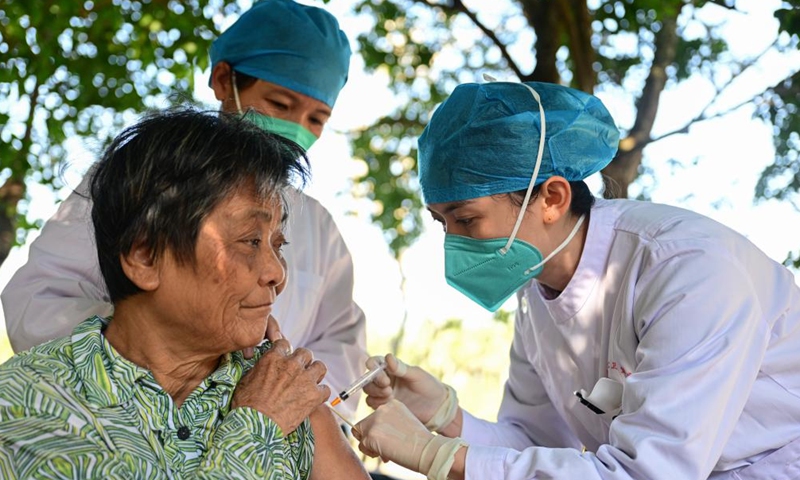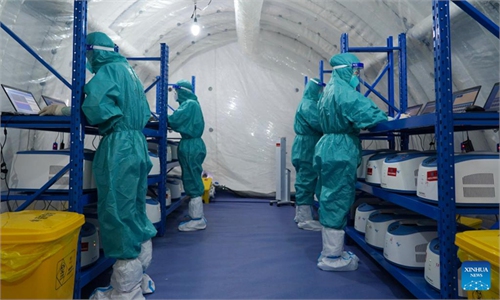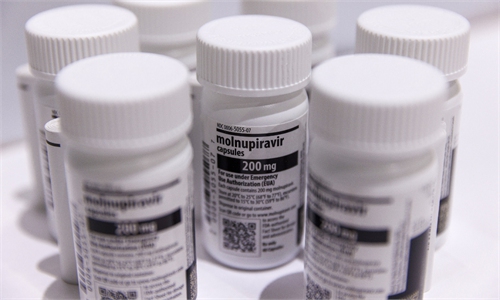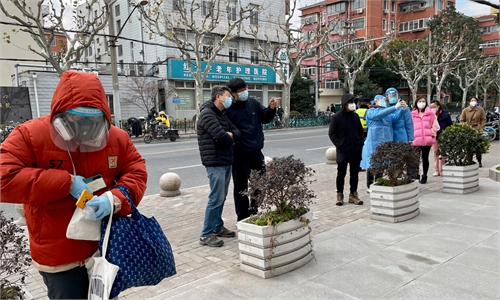
A medical worker administers a dose of COVID-19 vaccine to a senior resident in Hufeng Village of Wenchang, south China's Hainan Province, Dec. 22, 2022.The door-to-door services have been offered to help the elderly get COVID-19 vaccinations in the city of Wenchang. (Xinhua)
About 1.75 percent of more than 16,000 residents infected with COVID-19 reported no symptoms, according to the latest survey in the city of Ordos, North China's Inner Mongolia Autonomous Region. The city's COVID-19 infection rate surpassed 60 percent, Ordos's health authorities said.
In the past few days, many other regions in China released their reports of survey on their residents' health conditions. Southwest China's Sichuan Province also said that the province's infection rate is over 60 percent, while China's southmost Hainan's expected infection rate reached 50 percent.
It came after the country launched the second round of surveys to learn about the situation of residents infected with the coronavirus. The purpose of the investigation is to keep abreast of the pattern of the epidemic situation and provide targeted medical services to the public. The survey is carried out in the form of an online questionnaire, and anyone can participate anonymously.
The data from Ordos showed that of the 16,562 residents who identified themselves as infected with COVID-19, 78.89 percent had symptoms of fever, 68.93 percent had symptoms of headache, 64.88 percent had symptoms of cough, and 61.98 percent had muscle aches.
Respondents also reported symptoms such as loss of taste and smell, diarrhea, and difficulty breathing. Only 1.75 percent of all infected persons interviewed did not report any symptoms.
The Center for Disease Control and Prevention (CDC) of Ordos city launched an online survey of residents about COVID-19 infection on December 22, and data collection for the survey continued through Thursday midnight. A report of the survey was released on Friday.
Of the 27,502 residents who participated in the survey, 16,562, or 60.22 percent, reported COVID-19 infection.
Of the more than 16,000 people infected, 0.81 percent were seen in hospital outpatient clinics, 0.19 percent were hospitalized, 0.78 percent were seen through the internet, and 12.81 percent did not see a doctor or take medication. The remaining 85 percent of patients took their own medication.
Among the patients who took medication, 10.61 percent took Chinese herbal soup, 44.75 percent took traditional Chinese medicine, and 75.28 percent took Western medicine.
Of the 27,502 people who participated in the survey, 4.33 percent received 4 doses of vaccine, 70.61 percent received three doses of vaccine, and 18.16 percent received two doses of vaccine. 4.48 percent did not receive the vaccine.
Some 13,677 people reported that people living in the same apartment were infected, among them, 4,181 patients reported that elderly people over 60 years old at home were infected. And 7,337 people reported that minors living with them were also infected.
The COVID-19 infection rate of residents participating in the survey in Ordos was 60.22 percent, suggesting that the infection is at a high epidemic stage in the city, the Ordos CDC said in the report. More than 85 percent took medication on their own after infection, suggesting that medical institutions and community health service centers should strengthen online medication guidance.
When releasing the survey results, Ordos also said that the questionnaire did not collect sufficient sample representativeness and quantity, there were limitations in the data sources, and the results were for reference only.
In the results released by other regions, the COVID-19 infection rate also reached a high level.
The CDC of Sichuan Province released its survey result on December 26, revealing that the COVID-19 infection rate in the province's 21 city-level regions has reached 63.52 percent. In South China's Hainan Province, the expected infection rate is around 50 percent.
Two cities in East China's Zhejiang Province also unveiled the cities' infection rate. In Quzhou, about 30 to 35 percent of the residents have been infected with the virus. In Zhoushan, the health authorities expected that around 30 to 40 percent of residents have been infected.
Based on the comprehensive study by the experts, the upcoming chunyun will involve a large number of people moving, which will make the overall situation more complex, China's top epidemic expert Wu Zunyou said on Thursday.
All regions are trying the best to monitor, analyze and judge the information about the epidemic situation, and work to weaken the impact of the infection peak, Wu said.
In face of surging cases, medical institutions and authorities at all levels are ramping up efforts to allocate resources to relieve pressure among medical institutes, including boosting fever clinic capacity and increasing reserves of COVID-19 medication.
The State Council's joint prevention and control mechanism and the central leading group for rural affairs jointly published a work plan on Saturday, specifying to-dos to strengthen the grassroot-level epidemic control system, ensuring supplies of medicines and enhancing protection of vulnerable groups so that rural areas can cope with contagion risks linked to the holiday travel peak.
Global Times




